Shipwrecks lure most visitors who venture to Namibia’s Skeleton Coast, but the area boasts more than just rusting boats. If you’re willing to put in the driving hours and use your navigation skills, the Skeleton Coast is rich for exploration.
For as much as we loved our time on Namibia’s Skeleton Coast, we can’t wholeheartedly recommend Skeleton Coast National Park as an essential stop on your Namibia road trip. The land is desolate. The best attractions are unmarked. The amenities are minimal. But if you want to escape from civilization for a day or two, then the Skeleton Coast should be on your Namibia itinerary.
This guide will give you an overview of what you’ll find on the Skeleton Coast. We’ll cover all the shipwrecks that are easy to reach, as well as some that are suitable only for intrepid drivers. You’ll find out what kind of accommodation is available and how much time you’ll need to dedicate in order to get a feel for what this area of Namibia is all about.
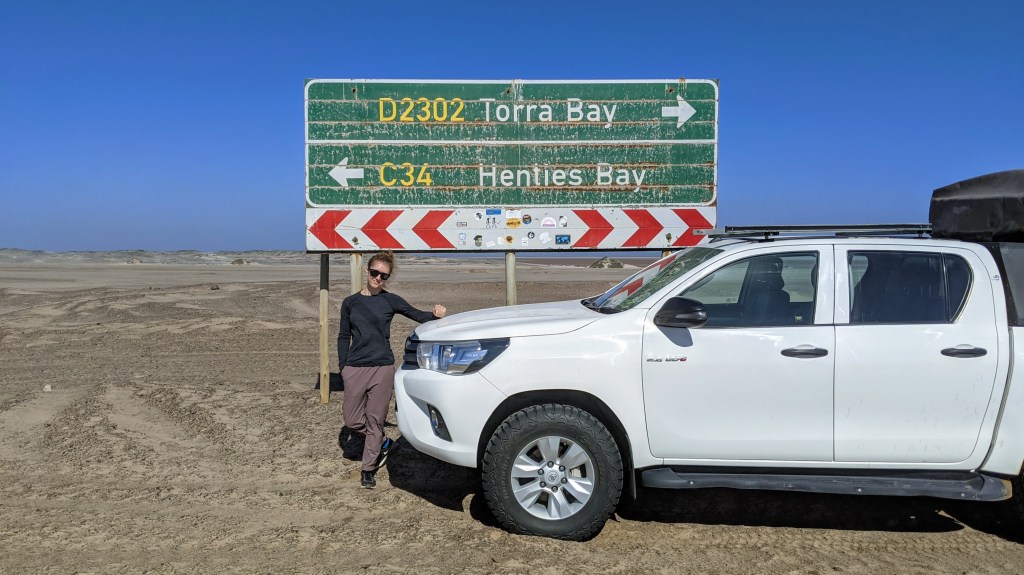
What’s Included:
- Where is the Skeleton Coast?
- The Highlights of the Skeleton Coast
- How do I Reach the Skeleton Coast?
- How to Spot Shipwrecks On the Skeleton Coast?
- Where Should I Stay on the Skeleton Coast?
- Who Should Stay Overnight in Skeleton Coast National Park?
- The Skeleton Coast – From Cape Cross to the Ugab River Gate
- The Skeleton Coast – From the Ugab River Gate to Torra Bay
- The Skeleton Coast – From Torra Bay to Terrace Bay
Where is the Skeleton Coast?
Skeleton Coast is a national park located on Namibia’s northern coast. It covers 6,200sq miles, but very little of this space is easily accessible to the public. There’s only 100 miles of accessible road. The last 200 miles of coast can only be reached by plane.
While the Skeleton Coast is technically a desert (it gets less than 10mm of rainfall annually), the landscape isn’t what comes to mind when you think of the desert. Rather than pale sand, the sand is dark brown, closer to dirt. The beaches are covered with large, round stones and the ocean is nearly always in view. You’ll see dunes, but they’re far off in the distance. If you’re lucky, you may spot the area’s elusive beach lions – lions that have adapted to living in the area’s arid environment.
Portuguese sailors referred to this area as the Gates of Hell, because of its strong winds, churning waves and dense fog that disoriented even the most experienced navigators. This caused countless shipwrecks in the area, many of which have no remaining traces. Those that do remain have been beaten by the elements, leaving only rusted-out hulls half-buried in sand.
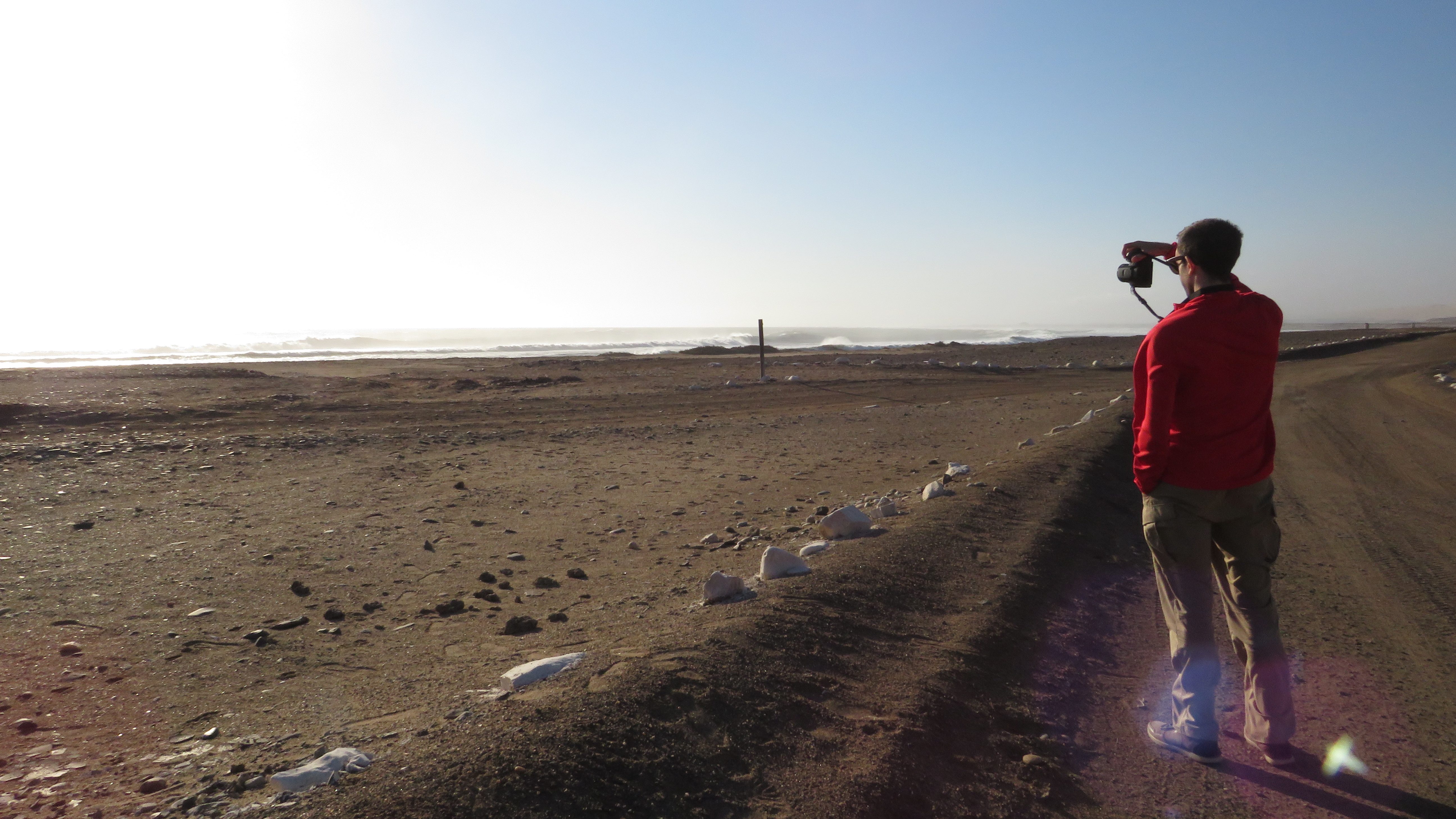
Highlights of the Skeleton Coast
- Spot shipwrecks. While the most intact and awe-inspiring wrecks are the trickiest to get to — such as the famed Eduard Bohlen located in the park’s far northern reaches — the ability to get up close to the remains of old machinery and ship hulls makes shipwreck-spotting a highlight of any Skeleton Coast tour.
- Spend the night at Terrace Bay. Getting to Terrace Bay resort takes time, it’s hours away from everything. But the atmosphere that greets you is worthy of the trip. From the informal restaurant to the dune driving tracks to the oceanside fishing, the end of the world atmosphere that pervades the resort is, we think, unmissable.
- Get up close with seals at Cape Cross. If you’ve ever wanted to experience a nature television show in real life, Cape Cross will thrill you. The quantity of seals is shocking. While their numbers fluctuate throughout the year, you’re sure to find the beach covered in seals, no matter when you visit. The noises they make as they flop around the beach adds a surprising, delightful dash of levity.
How Do I Reach the Skeleton Coast?
There are two ways to enter the park. You can enter via the Ugab River Gate, driving up from the south from Swakopmund, or you can enter via the Springbokwasser Gate, driving from the east via Damaraland.
Two roads run through the park, starting from each of the gates. There’s one that runs from south to north, from Cape Cross to Terrace Bay, and one that runs east to west, from Damaraland to Torra Bay.
If you’re staying in the park, you can enter either of these gates up to 5:00 pm, but you must be off the road by sunset. If you’re driving through the park without staying overnight, the last entrance through either gate is at 3:00 pm. We struggled to find these hours online before our trip, but confirmed them with both the gate signs and the NWR employees — check out our comprehensive post on driving in Namibia for details about gate opening times for Skeleton Coast National Park.
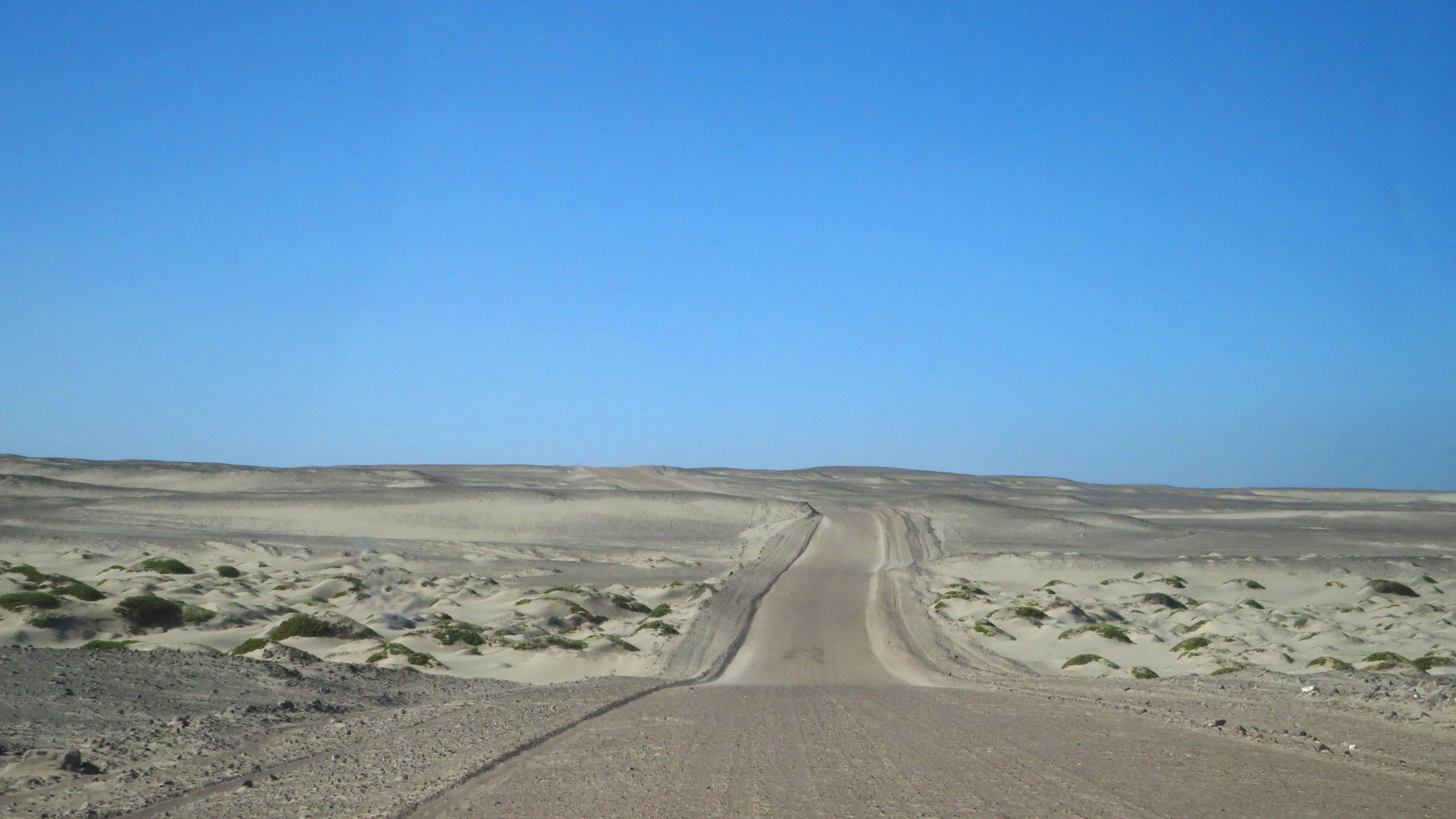
How to Spot Shipwrecks On the Skeleton Coast?
If you come to the area looking to explore shipwrecks, you’ll need extra navigational tools beyond a paper map and offline map app. A GPS is also essential if you’re looking to spot the best shipwrecks.
Tracks4Africa’s website has some GPS coordinates, which are useful for locating wrecks without roadside signs or that are slightly off shore. You can also use other resources to help you find GPS coordinates for wrecks. We advise you to take all these coordinates with a grain of salt. Information around Namibia’s shipwrecks is notoriously nebulous, and we’ve found countless websites posting disagreeing information or details that are blatantly incorrect.
During our trip, we stuck with the wrecks that could be easily accessed from off the road. These wrecks are generally well-marked. Still, we found offline maps invaluable in making sure we reached our destination.

Where Should I Stay on the Skeleton Coast?
If you’re choosing to spend the night in the Skeleton Coast national park, you have only two options you can reach by driving. Otherwise, you’ll need to stay at a fly-in lodge. They’re gorgeous but pricey! Staying overnight isn’t necessary to experience the park. In fact, many of the highlights can be seen during a day trip to the southern portion of the park.
Terrace Bay is the only year-round accommodation that’s reachable by car. It’s the farthest north you can go in your own vehicle without a permit. The property is run by NWR and consists of a series of beach front chalets. The vast majority of the people who stay here come to fish. Apart from a nearby 4×4 dune drive, there’s not much to do in the area.
All the standard chalets include breakfast (served from 7:00am to 9:00am) and dinner (served from 7:00pm to 9:00pm). Meals are taken at the restaurant, where the walls and ceiling are covered in notes from devoted guests who return year after year. There are a few larger premier chalets that have kitchens.
Further south, you’ll find Torra Bay. This NWR campsite is open only in December and January, during peak fishing season. From what we’ve heard, campsite pitches book up fast. Dedicated fishers flock to this site. It’s surreal to drive by Torra Bay out of season when it feels like a ghost down stranded in the desert. If you travel during the best seasons for touring the country, Torra Bay will be closed, though we do recommend stopping for photos as you drive along the Skeleton Coast.
If you’re looking to splash out, there are also fly-in lodges you can consider. These are limited to the park’s far northern reaches. Their remoteness is reflected in their price; some can fetch over $5,000 a night! If this is in your budget, we recommend checking out Shipwreck Lodge. Not only is the design appealing, the owners also run in-depth excursions to help you get the most out of your stay. See our section below on extending your stay for details.






Who Should Stay Overnight in Skeleton Coast National Park?
While an overnight stay on the Skeleton Coast might sound enticing, it’s not for everyone. The first reason is the time it takes to get to the area and the time it takes to drive around. The Skeleton Coast is huge. From the nearest entrance gate, reaching Terrace Bay will take almost two hours. That’s a lot of driving with beautiful scenery, but without many sights along the way! If your trip is on the shorter side, or if you want to spend a few extra days in Etosha or at Sossusvlei, then consider skipping an overnight stay. We also advise skipping the Skeleton Coast if you’re traveling with young kids who need constant entertainment.
Choosing to not stay in the Skeleton Coast doesn’t mean you need to leave it off your itinerary. Many of the area’s highlights can be easily reached in a day trip from Swakopmund or Walvis Bay. There are also local tour operators that offer day excursions into the park, and who have the inside knowledge to ensure you get to see the accessible shipwrecks, which are frequently hidden from view!
Consider staying on the Skeleton Coast if you’re interested in seeing all the shipwrecks (and willing to take the time to do so), if you are an enthusiastic fisher, if you relish exploring remote regions, or if you want to practice some off-road driving.
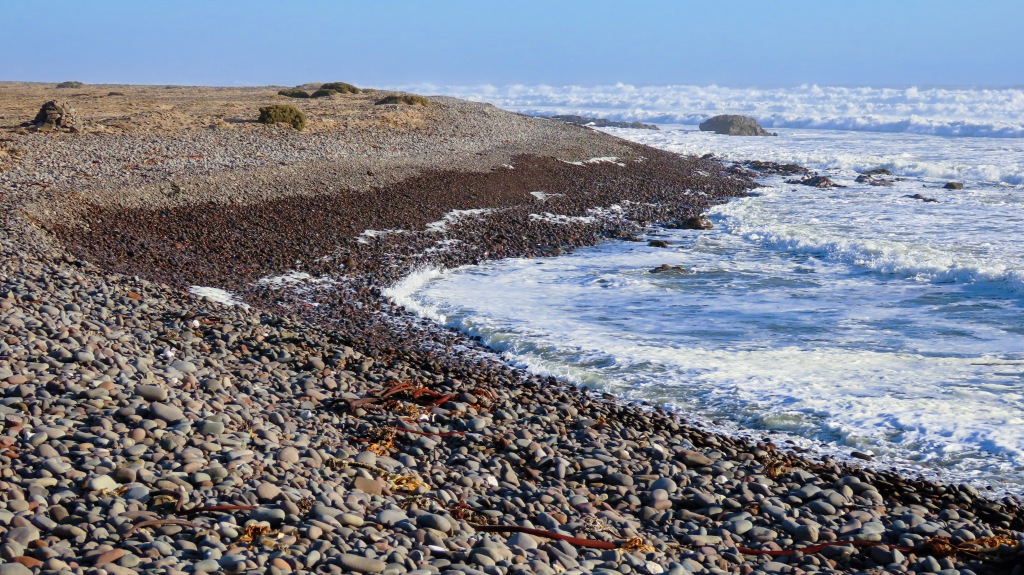
The Skeleton Coast – From Cape Cross to the Ugab River Gate
Immediately below the Skeleton Coast National Park lies Dorob National Park. While it’s a National Park for conservation reasons, it’s unique in Namibia in that you don’t have to pay a fee to transit through the park.
From Swakopmund headed north along the coast, the first destination you’ll come across is the Zelia shipwreck. It ran aground in 2008 and is the most intact wreck along the Skeleton Coast. Plus, you don’t need a 4×4 or any special driving skills to reach it. The Zelia was an Angolan fishing trawler that was being pulled to India to be sold as scrap. Today, it’s a must-see for tourists and birdwatchers. The relatively high volume of visitors attracts pushy gemstone sellers to the parking lot.
About 40 miles further north along the road, you’ll find the Cape Cross Seal Reserve. While it’s one of Namibia’s more expensive attractions — a permit costs 100 NAD per adult, plus 150 NAD for your car — you’ll know it’s worth it as a cacophony of seal bleats accosts you when leaving your car.
The Cape Cross Seal Reserve is home to the largest Cape Fur seal colony in the world. Over the course of the year, their numbers rise and fall according to mating season rituals. But no matter when you visit, there will be seals there vocalizing and lounging in the sun.
Walk a few meters south from the parking lot and you’ll find a replica of the cross erected by Portuguese explorer Diogo Cão in 1486 during a trip to find a new spice route between Portugal and India. The original cross is now in Berlin’s German Historical Museum and was removed in the late-nineteenth century when Namibia was under German control.
Leave Cape Cross and head north to the Winston and Stormkus shipwrecks. These wrecks are about 43 miles away. There is a well-marked turnoff with a sign for The Winston 4×4 track. Follow this track across a small salt flat until it peters out at the head of a sand beach. From there, turn slightly north and drive in the direction of the water. Do use your 4×4 and drive gently to avoid getting stuck in the sand. In just a few hundred meters a hunk of rusted metal should come into view. That’s the Winston Shipwreck.
The Winston was a South African fishing trawler that ran aground in 1970. While little remains today, it’s notable for being one of the few older shipwrecks that still sits on the coast. Most of the others have drifted inland, eroded completely, or been buried under shifting sand dunes. Depending on the tide, the Winston can also be hard to spot. It sits right at the tideline and can be submerged by waves during high tide.
Just a few hundred meters north of the Winston, also visible on the beach, you’ll find the Stormkus shipwreck. Even more rusted out, these few pieces of metal are still worth a look.
Once you’ve spent your time at the wrecks, drive 7 miles north to the Ugab River Gate. This is the official entrance into Skeleton Coast National Park, where you’ll have to pay your entrance fee. Be sure to snap a photo of the iconic skull and crossbones gate!
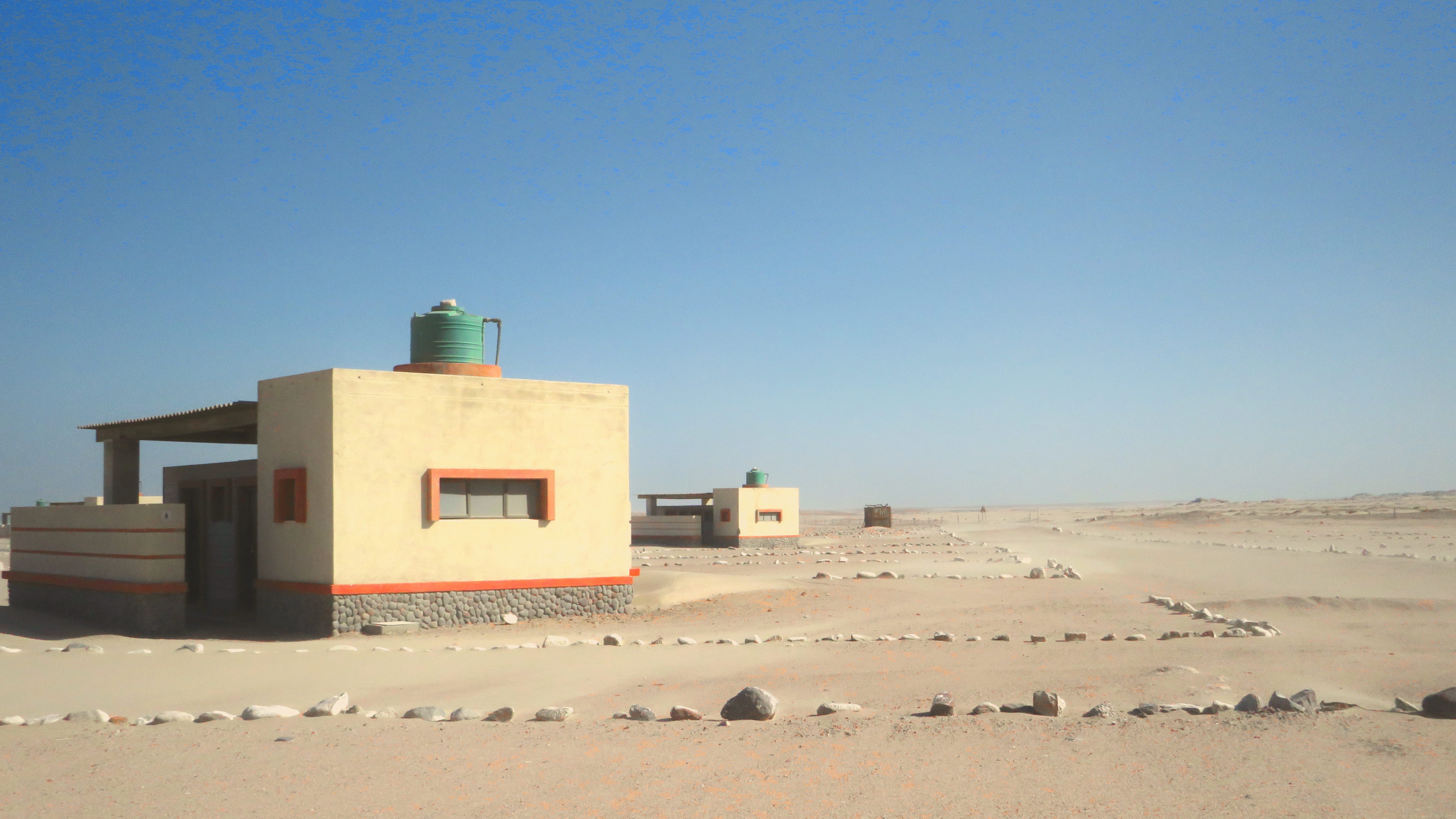
The Skeleton Coast – From the Ugab River Gate to Torra Bay
The first point of interest along the road will be the South West Seal overlook, where you’ll find the Benguela Eagle shipwreck. Drive up to the parking area, then walk down a small, steep incline to the water’s edge. There you’ll find the minimal remains of this former fishing vessel that ran aground in the 1970s (sources disagree about the specific year). While you’re there, be sure to check out the giant whale bones that are littered on the ground, which certainly put the name “Skeleton” in the Skeleton Coast.
Drive further north and you’ll come to the Huab River Overlook. This well-marked river delta is a surprisingly bucolic point, where you’ll be able to see all kinds of bird life including flamingos and the Damara rockrunner. Be sure to have your binoculars handy.
Just another 2 miles north and you’ll come across an abandoned oil rig. While this structure is sometimes confused for Toscanini, it’s a completely different experience. The remains are located on the inland side of the road. If the wind is blowing up a sandstorm, the most notable marker may be a break in the stones that line the road edge. A small rock sign labeled “Oil Rig” sits alongside the road as well. Follow the road to a parking area just a hundred meters from the road. From there you can walk to the oil rig and explore the remains of this structure, which is believed to have been operational in the 60s and 70s.
Afterwards, keep an eye out for Toscanini. While the area earns a big dot on the map, in reality it’s the blink-and-you’ll-miss-it remains of an abandoned diamond mine. As you approach, look out for a pair of white cement structures on the inland side of the road. If you park just south of these, you can climb to the top of a mini hill on the side of the road closest to the ocean to see what remains of the area’s foundations. There is nothing left here but building foundations and a few pillars of a former pier.
After Toscanini, the next notable spot you’ll approach is Torra Bay. This NWR campsite is operational only in December and January. Out of season, it becomes a nice place to stop and stretch your legs with the empty ablution blocks giving an eerie, end of the world atmosphere.
From here, you can head inland to exit the park through the Springbokwasser Gate. It’s about an hour’s drive away. Or, you can continue north to Terrace Bay, the furthest drivable reach of the Skeleton Coast.

The Skeleton Coast – From Torra Bay to Terrace Bay
While this stretch of road is necessary driving if you plan on staying at Terrace Bay, the only accommodation open-year round on the Skeleton Coast that’s accessible by car, it’s also one of the more desolate stretches.
A few miles north of Torra Bay, you’ll come to the Uniab Delta. This river is marked by a sign on the side of the road and also stands out for the tall grasses that appear seemingly at random. An abandoned concrete building at the side of the road marks both east and west turn offs which can be driven (in a 4×4) to reach various viewing points along the river. However, during the dry season this river holds no water and does not offer much to view.
After this, the rest of the drive north to Terrace Bay is spent watching the color of the sand slowly change from dark brown to slightly darker brown. Use your binoculars to try and spot beach lions, or pop in an audio book and relax. The road is in good repair, so your ride should be relatively smooth.
Just south of Terrace Bay, there is a 4×4 dune drive self-tour track if you want to test your sand driving skills and see the desert dunes up close
If you’re staying at Terrace Bay, you’ll check in at a large hangar, which functions as reception and a rec room (there’s a billiards table). Immediately across from reception, housed in an unassuming metal box, is the gas pump. This is a reliable fuel source, so do fill up if you need to. That being said, the power at Terrace Bay is turned off from 2:00pm to 5:00pm each day, so you’ll need to fill your tank in the morning.
Once you’ve checked into your room, take some time to walk down by the water. The beach is covered in large round stones, which makes for calf-testing walking. Exploring the remote area and taking photos is the main attraction here – and why you drove so far to be here!
